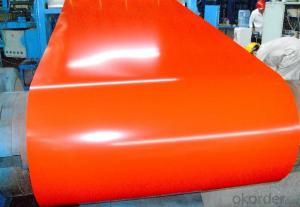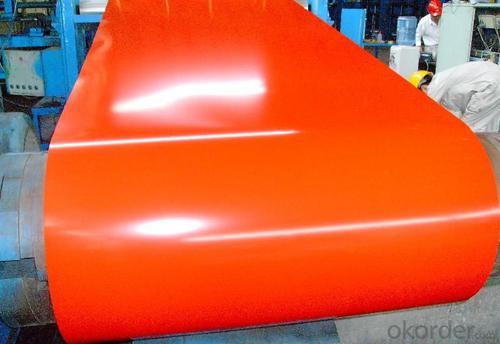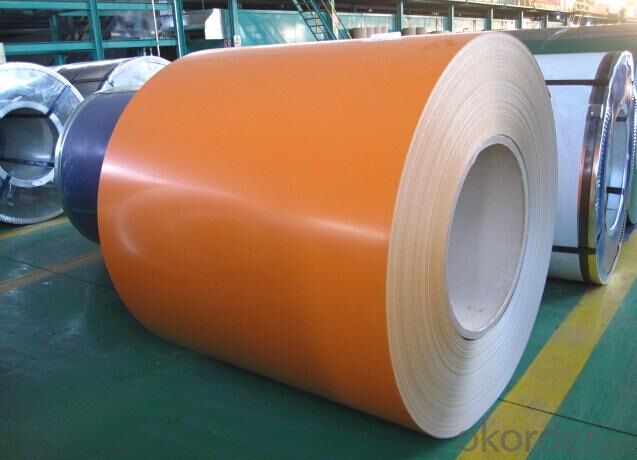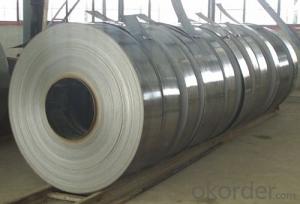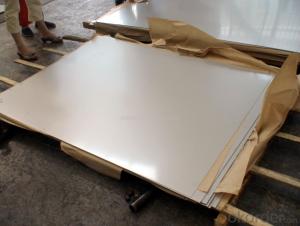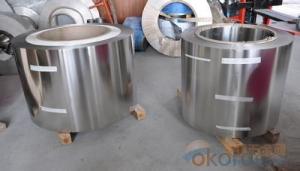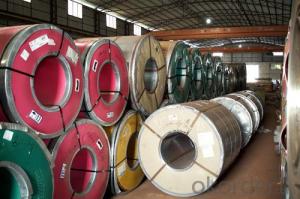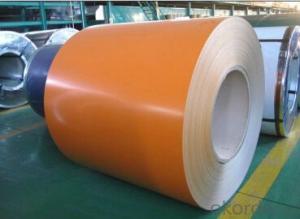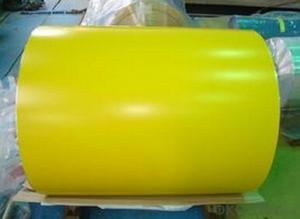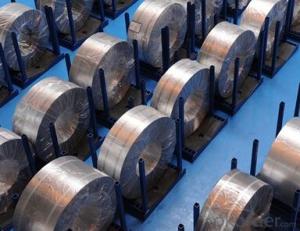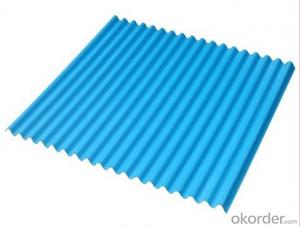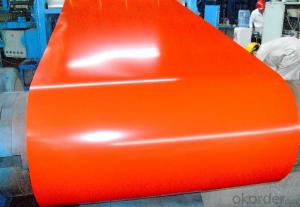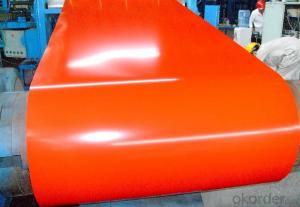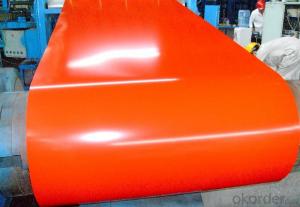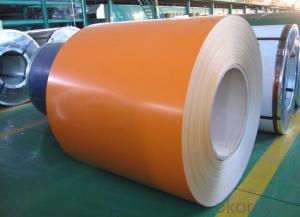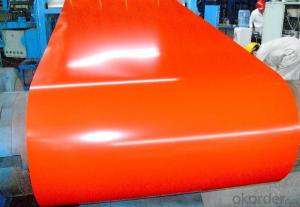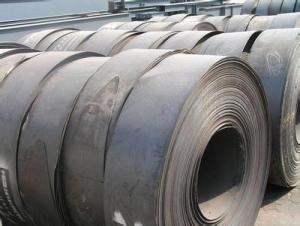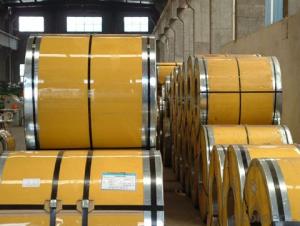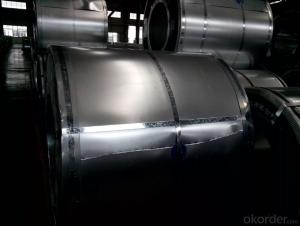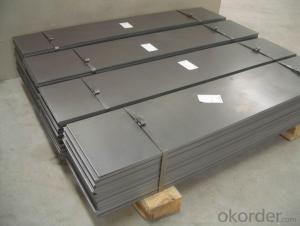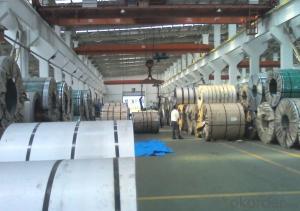Pre-painted Galvanized/Aluzinc Steel Sheet Coil with Prime Quality and Lowest Price Color is Orange
- Loading Port:
- Shanghai
- Payment Terms:
- TT OR LC
- Min Order Qty:
- 100 m.t.
- Supply Capability:
- 10000 m.t./month
OKorder Service Pledge
OKorder Financial Service
You Might Also Like
1.Structure of Pre-painted Galvanized/Aluzinc Steel Coil Description
With GI (aluzinc) as base metal, after pretreatment (degrease and chemical treatment) and liquid dope with several layers of color, then after firing and cooling, finally the plate steel is called pre-painted galvanized (aluzinc) steel. Pre-painted galvanized steel is good capable of decoration, molding, corrosion resistance. It generally displays workability, durability and weather resistance.
2.Main Features of the Pre-painted Galvanized/Aluzinc Steel Coil
• Excellent corrosion resistance
• Excellent weather resistance
• Capability of decoration, molding, corrosion resistance
• Workability, durability
• Excellent heat resistance performance
• High strength
• Good formability
• Good visual effect
3.Pre-painted Galvanized/Aluzinc Steel Coil Images
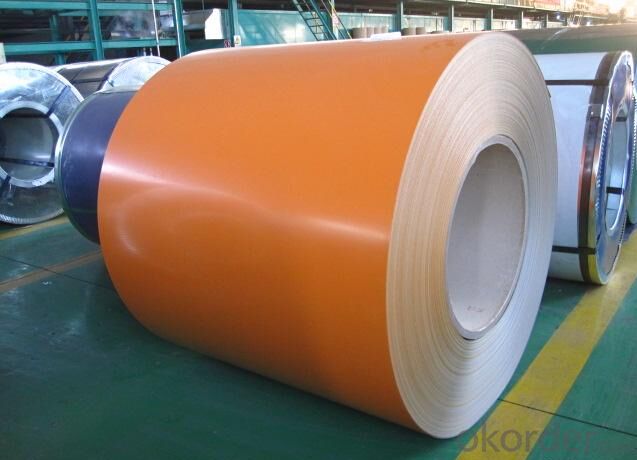
4.Pre-painted Galvanized/Aluzinc Steel Coil Specification
Quality standar: JIS G3312 CGCC & CGLCC
Hardness of P: Both soft and hard quality are available
Surface finish: with or without protect film
Thickness : 0.14-1.20 mm
Width : 914mm, 1000mm, 1220mm and 1250mm, thickness 600-1250mm is available
Finish by coil or sheet: Both sheet and coil are available
8Zinc coating: 60-275G/M2, both sides
Paint thickness for top side : 5 micron primer + (10-20) microns modified polyester, blue color code.
Paint thickness for back side: (5-10) microns Epoxy
Weight per coil: 4-6 tons, also can be upon customer's requirements
Max loading weight in one 20ft container : 25 tons generally
5. FAQ of Pre-painted Galvanized/Aluzinc Steel Coil
We have organized several common questions for our clients,may help you sincerely:
1. What is the minimum order quantity ?
Our MOQ is 50mt for each size. And we will consider to give more discount if you make big order like 1000 tons and more. Further more, the more appropriate payment term your offer the better price we can provide.
2. How long can we receive the product after purchase?
Usually within thirty working days after receiving buyer’s advance payment or LC. We will arrange the factory manufacturing as soon as possible. The cargo readiness usually takes 15-25 days, but the shipment will depend on the vessel situation.
3. How to guarantee the quality of the products?
We have established the international advanced quality management system,every link from raw material to final product we have strict quality test;We resolutely put an end to unqualified products flowing into the market. At the same time, we will provide necessary follow-up service assurance.
- Q: How are steel strips used in the production of metal packaging?
- Steel strips are used in the production of metal packaging in various ways. One common application is in the creation of metal cans, such as those used for food and beverages. Steel strips are first rolled into thin sheets and then cut into specific sizes and shapes to form the body of the can. These strips provide the necessary strength and durability to withstand the pressure and weight of the contents inside the can. Additionally, steel strips are utilized in the production of metal lids and closures for cans. These strips are shaped and formed into the desired lid design and then attached to the can body. The use of steel strips ensures that the lids are tightly sealed, preventing any leakage or contamination of the packaged goods. Steel strips also play a crucial role in the production of metal drums and barrels. These containers are commonly used for storing and transporting various liquids, chemicals, and hazardous materials. The steel strips are rolled and welded together to form a sturdy cylindrical structure, capable of withstanding the weight and pressure exerted by the contents. The strips are also instrumental in providing the necessary rigidity and strength to prevent any deformation or damage to the drum during handling and transportation. In summary, steel strips are essential components in the production of metal packaging. They are used to create the body of cans, lids, and closures, as well as the structure of drums and barrels. The versatility and strength of steel make it an ideal material for ensuring the integrity and safety of the packaged goods.
- Q: What are the cleaning methods used for steel strips?
- There are several effective cleaning methods used for steel strips, depending on the specific type of contamination and desired level of cleanliness. Here are some common cleaning methods used: 1. Mechanical Cleaning: This method involves using mechanical abrasion techniques such as brushing, scrubbing, or sanding to physically remove dirt, grease, or other contaminants from the surface of the steel strips. Mechanical cleaning is effective for removing heavy deposits or rust that may be present on the strips. 2. Chemical Cleaning: Chemical cleaning involves using various cleaning agents such as solvents, alkaline solutions, or acidic solutions to dissolve or loosen dirt, grease, or other contaminants from the steel strip's surface. This method is particularly useful for removing organic residues or light surface contamination. 3. Electrolytic Cleaning: This method utilizes an electrolyte solution and an electrical current to remove contaminants from steel strips. Through the process of electrolysis, the electrical current causes the contaminants to detach from the surface and migrate to a separate anode or cathode, leaving the steel strip clean. 4. Ultrasonic Cleaning: This method involves immersing the steel strips in a tank of liquid cleaning solution and subjecting them to high-frequency ultrasonic waves. These waves create microscopic bubbles that implode, generating intense cleaning action and effectively removing dirt, oil, or other contaminants from the surface of the strips. 5. Pickling: Pickling is a chemical cleaning method where the steel strips are immersed in an acid solution, typically a mixture of hydrochloric acid and sulfuric acid. The acid removes any oxide scale, rust, or other surface impurities from the steel, resulting in a clean and smooth surface. 6. Steam Cleaning: Steam cleaning is an efficient method that uses high-pressure steam to clean steel strips. The steam's heat and pressure effectively remove dirt, oil, or other contaminants from the surface, leaving the strips clean and sanitized. It is important to select the appropriate cleaning method based on the nature of the contamination, the type of steel strip, and the desired level of cleanliness to ensure optimal results and prevent any damage to the strips.
- Q: How are steel strips processed for wear resistance?
- Steel strips can undergo various processes to enhance their wear resistance. One common method is through heat treatment, where the steel strips are heated to a specific temperature and then cooled rapidly to form a hardened surface. This process, known as quenching and tempering, helps to increase the hardness and strength of the steel, making it more resistant to wear. Another technique used is the application of coatings or surface treatments. These can include processes such as electroplating, where a layer of a different metal is deposited onto the surface of the steel strip, creating a protective barrier against wear. Other surface treatments like nitriding or carburizing can also be employed to increase the surface hardness and wear resistance of the steel strip. Additionally, steel strips can be subjected to mechanical processes like shot peening or grinding. Shot peening involves bombarding the surface of the strip with small metallic or ceramic particles, which induces compressive stresses and improves its resistance to fatigue and wear. Grinding, on the other hand, removes a thin layer of material from the surface, exposing fresh, harder layers underneath and improving wear resistance. Overall, the processing of steel strips for wear resistance involves a combination of heat treatment, surface coatings, and mechanical treatments. These techniques help to improve the hardness, strength, and overall durability of the steel, making it more suitable for applications where wear resistance is crucial.
- Q: How are steel strips processed for load-bearing capacity?
- The load-bearing capacity of steel strips is improved through a series of manufacturing and treatment processes. Firstly, the suitable grade of steel is selected to enhance load-bearing capacity. Different grades of steel possess varying mechanical properties, including yield strength and tensile strength, which directly impact load-bearing capacity. Applications requiring greater load-bearing capacity often opt for higher strength grades like high-strength low-alloy (HSLA) or advanced high-strength steel (AHSS). Once the steel grade is determined, the steel strips undergo a series of manufacturing processes. Typically, the strips are either hot-rolled or cold-rolled to achieve the desired thickness and shape. Hot-rolling involves heating the steel above its recrystallization temperature and passing it through rollers to reduce thickness and shape it into a strip. On the other hand, cold-rolling is performed at room temperature, resulting in a smoother finish and tighter tolerances. After the initial rolling process, the steel strips may undergo additional treatments to further enhance their load-bearing capacity. One commonly used treatment is heat treatment, which involves heating the steel to a specific temperature and then rapidly cooling it to alter its microstructure. This process increases the strength and hardness of the steel, thereby improving its load-bearing capacity. Other treatments may involve applying surface coatings or galvanization to protect the steel from corrosion, which can weaken its load-bearing capacity over time. Coatings such as zinc or epoxy provide an added layer of protection against environmental factors that may compromise the integrity of the steel strips. In conclusion, the process of enhancing the load-bearing capacity of steel strips involves selecting the appropriate grade of steel, followed by manufacturing processes such as hot-rolling or cold-rolling. Additional treatments like heat treatment and surface coatings are utilized to further improve load-bearing capacity and safeguard against corrosion.
- Q: What are the different welding techniques used for steel strips?
- There are several welding techniques commonly used for steel strips, including resistance welding, fusion welding, and laser welding. Resistance welding involves passing an electric current through the steel strips to generate heat and create a weld. Fusion welding, on the other hand, involves melting the edges of the steel strips and fusing them together. Laser welding uses a high-powered laser beam to melt and join the steel strips. Each technique has its advantages and is chosen based on factors such as the thickness of the strips, desired strength of the joint, and production requirements.
- Q: Can steel strips be used in the production of bicycle frames?
- Yes, steel strips can be used in the production of bicycle frames. Steel is a commonly used material in the manufacturing of bicycle frames due to its strength, durability, and affordability. Steel strips can be shaped and welded together to create the main structure of the frame, providing a solid and rigid foundation. The use of steel strips allows for flexibility in design and customization, as different shapes and sizes can be easily achieved. Additionally, steel frames offer excellent ride quality, as they absorb vibrations and provide a smooth and comfortable riding experience. Overall, steel strips are an ideal choice for bicycle frame production, offering a combination of strength, durability, and versatility.
- Q: How are steel strips processed for surface slitting?
- Steel strips are processed for surface slitting by first unwinding the coil and feeding it through a slitting machine. The machine has circular blades that cut the steel strip into narrower widths. The slitted strips are then rewound into separate coils according to the desired width. This process allows for precise and efficient cutting of steel strips for various applications.
- Q: What are the cost considerations when using steel strips?
- When using steel strips, there are a few cost considerations to keep in mind. Firstly, the price of the steel itself can vary depending on factors such as quality, grade, and market demand. Additionally, transportation costs should be taken into account, especially if the steel strips need to be shipped over long distances. Another factor to consider is the cost of processing, such as cutting, shaping, or coating the steel strips, as these services may incur additional expenses. Lastly, it is important to factor in any potential maintenance or replacement costs that may arise over time. Overall, understanding the various cost considerations associated with steel strips can help in making informed decisions and managing budget effectively.
- Q: What is the fatigue strength of a steel strip?
- The fatigue strength of a steel strip refers to its ability to withstand repeated loading and unloading cycles without failure. It is a measure of the strip's resistance to fatigue and is typically determined through fatigue testing.
- Q: What are steel strips made of?
- Carbon steel is the typical material used for making steel strips. It is an alloy of iron and carbon, with the carbon content varying depending on the desired properties and end-use applications. Additional elements like manganese, silicon, and sulfur may also be included to improve specific characteristics of the steel. The steel is melted and cast into billets, which are long rectangular shapes. These billets are then hot-rolled through rolling mills to gradually reduce their thickness and shape them into thin, long strips. As a result, the steel strips possess outstanding strength, durability, and versatility, making them suitable for a range of industries including automotive, construction, manufacturing, and more.
Send your message to us
Pre-painted Galvanized/Aluzinc Steel Sheet Coil with Prime Quality and Lowest Price Color is Orange
- Loading Port:
- Shanghai
- Payment Terms:
- TT OR LC
- Min Order Qty:
- 100 m.t.
- Supply Capability:
- 10000 m.t./month
OKorder Service Pledge
OKorder Financial Service
Similar products
Hot products
Hot Searches
Related keywords
